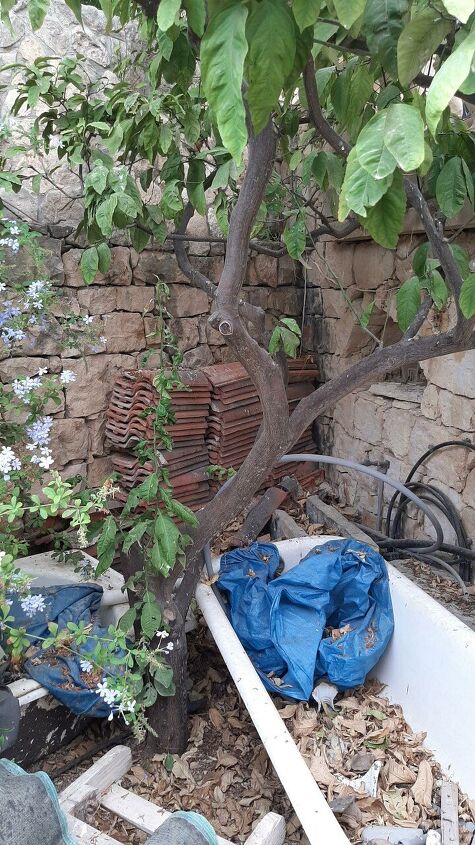Transplanting a Lemon Tree
Seeking Advice on Successfully Transplanting a Lemon Tree?
I have a healthy lemon tree tucked away in the back corner of my house, in an area that's become a bit of a storage spot over the years. The tree itself is thriving, and I'd love to give it a new lease on life by transplanting it to my front garden.
My goal is to ensure the lemon tree not only survives the transplant but continues to flourish and bear fruit in its new location where the family can enjoy its beauty and delicious lemons.
I would be extremely grateful if anyone here has experience with transplanting lemon trees and can offer guidance.
Thank you
Related Discussions
Help with 80's bathroom in a new home!
We are moving into a new home and want to update this bathroom vanity first. We do not want to update flooring as it the same throughout the whole house (except some ... See more
How do I hang this address plaque?
I want to hang this address plaque, but I don't want to damage my brand new siding. Any suggestions?
How long does paint need to dry?
We are having our kitchen cabinets painted but I'm nervous about putting the doors back on too soon. How long should we wait before reattaching them?
Can you mix silver grommet curtains with a bronze rod?
Would like to purchase curtains but the grommets are silver my rods are brown.
We just purchased a house with a crawl space and no landscaping
What can I plant around the house ... Is there anything I should stay away from?
Paint separating from the wall
There are 3 spots in the picture where the paint is bubbling up on the wall. The layer of paint that is seperating seems quite thick (roughtly 2mm). Does anyone know ... See more
What do I need to know about covering surfaces with contact paper?
I am really intrigued by the idea of upgrading some of the surfaces in my apt with contact paper. What do I need to know? What is the best method to apply it? How ... See more





Hope this helps
https://www.hunker.com/13428706/when-to-transplant-lemon-trees
https://www.doityourself.com/stry/transplanting-a-lemon-tree
https://www.gardeningknowhow.com/edible/fruits/lemons/transplanting-lemon-trees.htm
Hopefully this video can help out! https://www.youtube.com/watch?v=-cIfQUK7aIA
Hi Dustin! You can gently lift the tree by the trunk and set it upright on the new container. Add more potting mix around the root ball while tamping down the soil to prevent any air pockets from forming and at the same time for the soil to support the root ball. Water the newly repotted tree until the soil becomes well moistened.
If it were me, I would ask the experts at the Garden Nursery.
You could look to your Cooperative extension for help. It looks like you live in a warm climate and can have it thrive in the ground, you are so fortunate. We have had lemon trees in the past (Maryland), in pots and they get real heavy to move in and out during seasons. I have repotted them as they grew larger. The soil should be one where they get lots of vital nutrients, look to a garden center for tree soils for it's new home.
If this were my tree and it is well established in where it is at, I would clean up the area and leave it be, just keep watered and fertilized.
Your best bet might be to contact a local arborist as they know your area in and out as well as being a tree expert. They will have the exact info you need for success.
Hi Dustin, hope this helps you out.
The best time to transplant citrus is in the spring. Get as much of the root ball as possible, dig the hole wider than deep and add nothing to the hole. Set the plant in the ground slightly (1/2-1 inch) higher than it grew in the ground. Re-fill the hole around the plant about 1/3 to 1/2 full, then water and gently tamp the soil thoroughly to remove air pockets. Allow the water to settle, fill the hole 2/3 full of soil, re-water and tamp again. Finish filling the hole and pack the soil firmly around the tree. Form a water basin around the tree at least 3-4 inches high and 30 inches in diameter. Do not put mulch over the root ball. Water 3 times a week for 2 weeks, and then taper off gradually to once a week during periods of little or no rainfall. The basin should stay in place until the tree is well established. Avoid pruning the tree prior to transplanting (this would apply to any tree or shrub); you want to encourage the tree to put its energy into growing roots. Pruning citrus should not be necessary except to shape the trees or remove water sprouts or suckers. Do not leave stubs as they may be attacked by rotting organisms which could damage the tree. Fertilization could be done in June and then again in the fall between Oct. and November. The recommended 3 applications per year can be made in January – February, May – June and October – November although timing is not especially critical. Good luck
What zone do you live in?
Get as much of the root ball as possible, dig the hole wider than deep and add nothing to the hole. Set the plant in the ground slightly (1/2-1 inch) higher than it grew in the ground. Re-fill the hole around the plant about 1/3 to 1/2 full, then water and gently tamp the soil thoroughly to remove air pockets.
Hi Dustin: Never done this before, but it should be similar to transplanting any tree. Dig the hole twice as large as you need, make sure the sides and bottom of the hole are not slick, but bumpy and even soft so that the roots can get into the dirt. Also, make a hump in the middle of the hole and spread the roots over and around this hump, sort of like an octopus :), so that the roots don't go around the hump, but sort of straight out. Also, what I like to use is a product called Root Tone. The hormones stimulate the roots to grow faster, thus reducing the risk of transplant shock. It is especially helpful in plants that have had their roots pruned or cut.
Here's a site that talks about using a rooting hormone:
https://covingtonnaturals.com/blogs/news/what-are-the-pros-cons-of-using-a-rooting-hormone
This site tells about transplanting citrus trees:
https://www.dailynews.com/2017/07/03/gardening-transplanting-citrus-trees-takes-care-and-effort-but-it-can-be-done/
Good luck :)